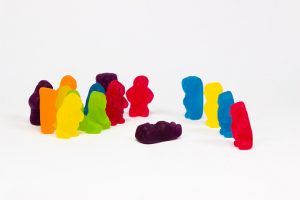
Fructose is a link in the metabolism of glucose; yet there is no real need for dietary fructose. When ingested by itself, fructose is not absorbed very well and is mostly cleared by the liver. When the liver gets overloaded it starts turning the fructose into fat.
Although it seems to be common knowledge that a diet high in sugar is not a good idea, statistics show that high fructose corn syrup intake in the United States is an overwhelming 55 pounds per person each year.
In the United States, a sweetener called HFCS is added to processed foods, including breads, cereals, soups, lunchmeats and condiments. It’s actually made up of sucrose and fructose – the majority being fructose. In its natural form (fruit) paired up with fiber, it has a much slower absorption rate. This means there are lower risks of insulin spike and diabetes. It is very different from processed fructose found in corn syrup.
Over the years, studies have suggested there are many negative effects of fructose. Obesity, type-2 diabetes, heart disease and some forms of cancer have been linked to fructose.
High fructose diet slows recovery from traumatic brain injury
This latest research suggests that fructose disrupts the pathways between the brain cells when we learn or experience something new. For people who are trying to recover from traumatic brain injury and are struggling to relearn, this makes it even more difficult.
High fructose diet also affects learning and memory
The high fructose diet showed the rats developed insulin resistance. Insulin can penetrate the blood-brain barrier. Researchers suspect the hormone may signal neurons to trigger reactions that can disrupt learning and therefore cause memory loss. They concluded that eating too much fructose could block the insulin’s ability to store sugar for energy. Energy is required for processing thoughts and emotions. The whole idea that a high-fructose diet hurts the brain, as well as the body, is a relatively new revelation.
High fructose corn syrup side effects
While disrupting insulin is one factor, as mentioned above, there is also research to suggest that high fructose has an impact on triglyceride levels and LDL (bad) cholesterol levels. Since fructose goes straight to the liver to metabolize, it is more likely to be converted into fatty acid and add to the triglyceride load, as well as cholesterol level. High cholesterol is a major risk factor for heart disease and stroke.
Reading labels when you go to the market and cooking with less sugar can help keep you healthier. The American Heart Association guidelines suggest no more than 100 calories of added sugar per day for most women, while men should limit their daily intake to no more than 150 calories. This works out to about six teaspoons of sugar for women and nine for men.
Reducing sugars in your diet
The United States Department of Agriculture estimates that close to 40 percent of the added sugars Americans consume come from soda and sports drinks. If you are a regular drinker of sweetened beverages, try to slowly scale back and if you can, get to the point where you have eliminated them completely from your diet.
Sugar comes in different forms; fructose or syrup, sugar, sucrose, dextrose, and maltose are just a few examples. When you pick something up off the shelf at the market and you read more than three different forms of sugar on the label, consider putting in back on the shelf and looking for a substitute.
When it comes to desserts, opting for homemade is best. That way you can control the sugar content. Keep in mind, you don’t have to use the same amount of sugar or syrup the recipe calls for. Often using half or three-quarters of what is called for does not hurt the taste or consistency of what you are baking.
Almost eleven percent of the average American’s caloric intake comes from fructose. It’s hard to believe when you consider that high fructose syrup has a fairly young history. It was first introduced to consumers in the early 1970’s, but did not take long to penetrate the American diet.
While some people just happen to have a sweet tooth and love sugary drinks, cookies, cakes, candy and fructose-filled processed foods, the risks associated with such a diet could end up being a bitter pill to swallow.